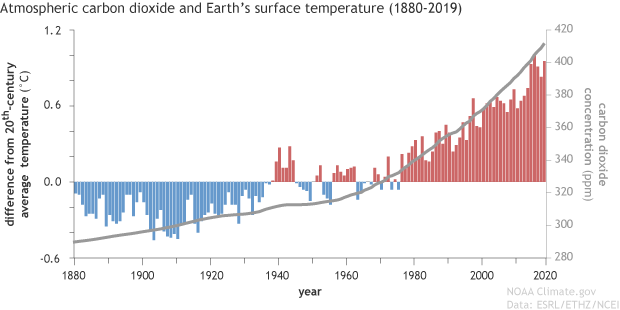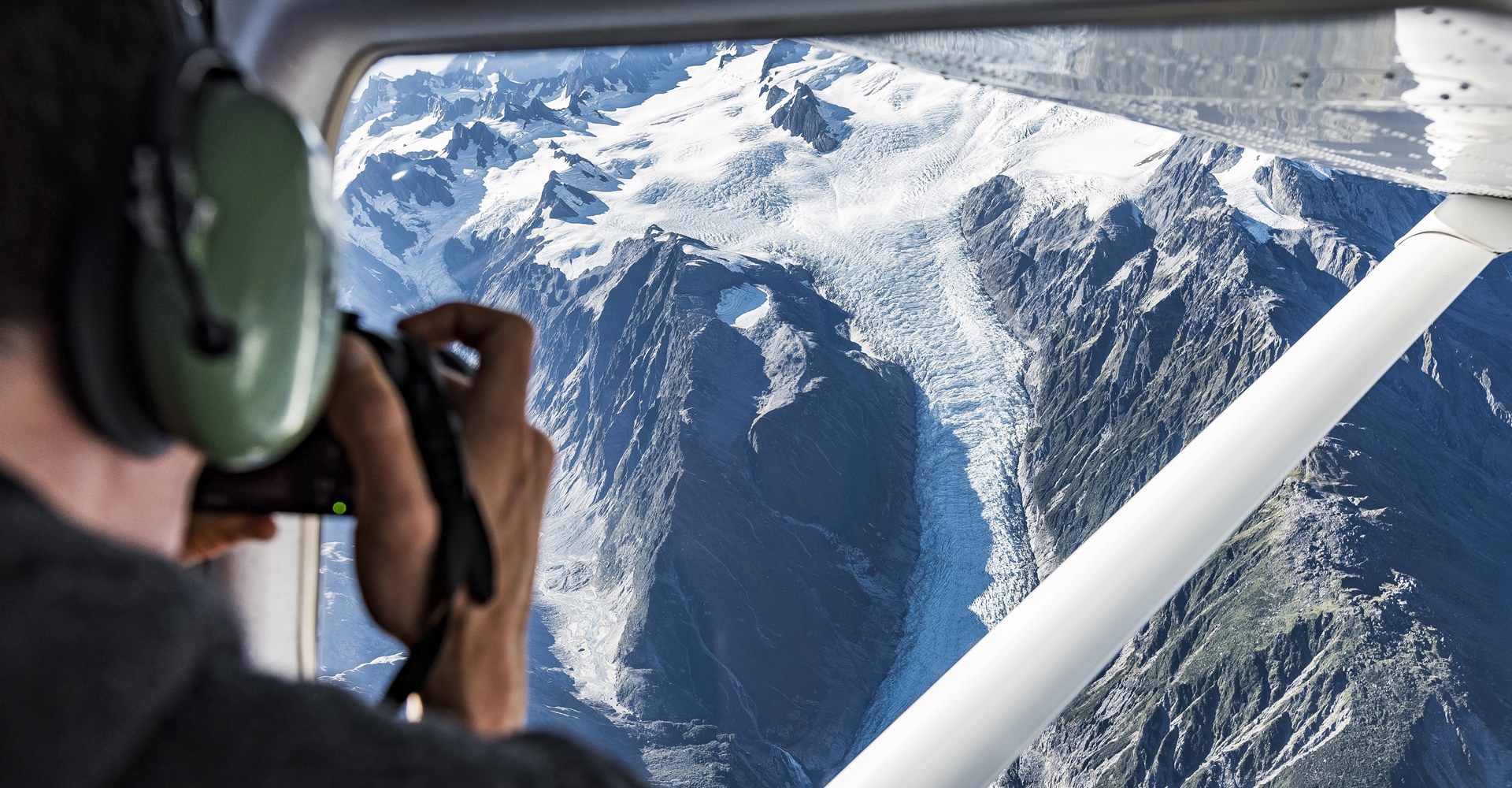what do scientists use to understand past climates?
Written by Sam Fraser-Baxter, NIWA Communications Advisor
On this page:
- Why is it important to monitor our irresolute climate?
- How practise nosotros monitor the climate?
- What are some of the tools climate scientists employ to monitor climate?
- Action – show your stripes
- Quiz – agreement past climate can assist predict the hereafter
Download a shorter version of this lesson in PowerPoint or as a PDF or go on beneath to see the lesson in full.
You might be surprised to hear that scientists study the by to try and predict the futurity. Merely if nosotros can sympathize how the Earth's climate has inverse in the past, we tin employ that information to understand how it might change in the futurity.
In this lesson, we're going to learn about the importance of monitoring climate change, the tools scientists apply to monitor the climate and how observations are used to predict the future.
Why is information technology important to monitor our changing climate?
The earth's climate has been changing naturally for billions of years.
But at the commencement of the Industrial Revolution in the 18th century, humans started to release large amounts of greenhouse gases into the atmosphere, causing the globe'due south climate to warm and change.
This has greatly accelerated natural atmospheric processes (not caused past human activities) that cause the climate to change.
Ongoing monitoring of the climate is essential – we demand to have skillful, accurate scientific observations to best understand climate change and set for the future.
How practise we monitor the climate?
For decades, scientists have used climate and weather condition stations to record atmospheric and weather weather condition like temperature, rainfall, humidity and wind. They take authentic measurements that help us understand year to yr climate variability and long-term trends.
Simply, how do scientists know what the climate was doing thousands or even millions of years agone?
At that place are natural ecology clues that nosotros can study to understand the past climate – ice cores and tree rings are ii examples. These natural recorders are like puzzle pieces of the by – scientists piece them together to understand what the climate might have been like way dorsum then.
And then, how does all this information help us predict what time to come climate might be like? Scientists create powerful reckoner models and simulations that include data near our past climate and gauge how the climate might change in the future. The next lesson will teach you more about computer models.
Carbon dioxide
Carbon dioxide is a helpful gas to look at when we talk about climate change. For millions of years, in that location has been a close relationship betwixt the amount of carbon dioxide in the atmosphere and the globe's temperature. The graph beneath shows how carbon dioxide and temperature have gone upwards and down together over the past 400,000 years.
Yet, there has been a dramatic increase in carbon dioxide over the past 250 years primarily due to the called-for of fossil fuels past humans, which means that temperature is going to keep increasing too.

The next graph shows how temperature has increased over the past 150 years in response to increasing carbon dioxide (too as other greenhouse gases) in the atmosphere.

What are some of the tools climate scientists employ to monitor climate?
Now , we're going to await at some of the tools that scientists use to monitor the climate.
NIWA's 7-station temperature series
In New Zealand, NIWA's vii-station temperature serial helps united states sympathize how our national average temperatures have changed over a long period of time. These climate stations, in seven locations around the country, collect important data which helps united states of america sympathise temperature trends. The stations are in Auckland, Wellington, Masterton, Nelson, Hokitika, Lincoln, and Dunedin, and accept been operating since 1909.
The below 'climate donut' graph was created with information from the seven-station series. Designed in January 2020, the graph shows that since 1909, New Zealand is having more frequent months with warmer or 'above boilerplate' temperatures. In fact, the concluding time we had a cooler than average month was January 2017.

Atmospheric condition stations
As well as these 7 stations, NIWA has a network of over 200 weather stations across the country, and shares data with the public through the National Climate Database, MetService and other partners, who have at least another 200 stations. All together, New Zealand's network of monitoring stations requite us an authentic picture of what's happening with our weather condition and climate – from the mountains to the sea. Some of New Zealand'south oldest weather stations have records going back to the 1850s – how cool is that!
Written and oral records
Written and oral records made by humans in the past can too be used to understand past climates.
For example, in the by, sailors at sea all over the world kept detailed logbooks of atmospheric atmospheric condition to assist them with navigation and to sympathise what conditions conditions might exist coming over the adjacent few days – in that location were no weather condition forecasts in those days. NIWA has been using these old records from sailors to reconstruct different by climates. This is particularly of import for building up a longer historic climate record in the Southern Hemisphere where there is a lot of ocean with no climate stations in place!
Glaciers
A glacier is like a large river of water ice that responds to a changing climate. When the climate is cooling, glaciers increase in size and accelerate further downhill every bit more snow and water ice accumulates. When the climate is warming, glaciers tend to cook and decrease in size, causing them to retreat uphill. Scientists tin study these movements of glaciers, as well every bit the markers they go out on the landscape equally they retreat (such equally piles of rock called moraines), to understand changes in our climate.
Glaciers in the Southern Alps of the South Island are estimated to have lost more than than 30% of their volume over the last 40 years.

Tree rings
Studying growth rings in a tree can tell the states how one-time a tree is, and sometimes what the climate was like during each year of its life. The width of a tree ring may depend on environmental factors such as temperature, rainfall and soil moisture. Scientists tin can employ this information to reconstruct past climates. The Kauri tree, which just grows in northern New Zealand, is i of the best tree species in the world for doing this kind of research as they alive for a very long time and sometimes have over 1000 rings!

Ice cores
An ice core is a sample of ice taken from a sheet of ice or from a glacier. Scientists use ice cores to empathize the temperature and the amounts of different greenhouse gases in the temper at the fourth dimension the snow cruel and froze to become ice. Ice cores tin be really helpful because they can help united states of america understand by climates hundreds of thousands of years ago.

Activeness – show your stripes
Show Your Stripes is a website that creates a visualisation showing how the climate has inverse in dissimilar parts of the world. The website uses long-term temperature data collected from around the world and the colour of each stripe represents the temperature of a year. The cooler years are white and blue and the warmer years are orange and red.
What you'll need:
A computer with access to the internet. Go to https://showyourstripes.info/.
Instructions:
- Separate the class into modest groups (two-3 students per group).
- Assign a different region to each group and enquire the students to download a Climate Stripes image for a country in their assigned region.
- Ask the students to discuss in their groups what the visualisation is showing.
- As a grade, talk over the similarities and differences for unlike regions of the world and why at that place are differences
Explanation:
While every region shows a warming trend, there are differences in each region. This is considering climates vary all around the world and are irresolute at unlike rates and in different means.
The image below from Berkeley Globe shows variable rates of warming across the earth over the past 50 years:

Quiz – understanding by climate can help predict the time to come
Check out our weather and meteorology quiz over on Kahoot.
(The quiz works best on kahoot, but if yous prefer a text version, you can download it as a PDF here).
Climate change information for climate solvers
For more than data about the science of climate change, visit our web pages aimed at school students. The things we can practice to combat climate change, individually, and alongside our whānau, school and community, can and will brand a divergence.
Source: https://niwa.co.nz/rangi/lesson-11-understanding-past-climate-can-help-predict-the-future
0 Response to "what do scientists use to understand past climates?"
Postar um comentário